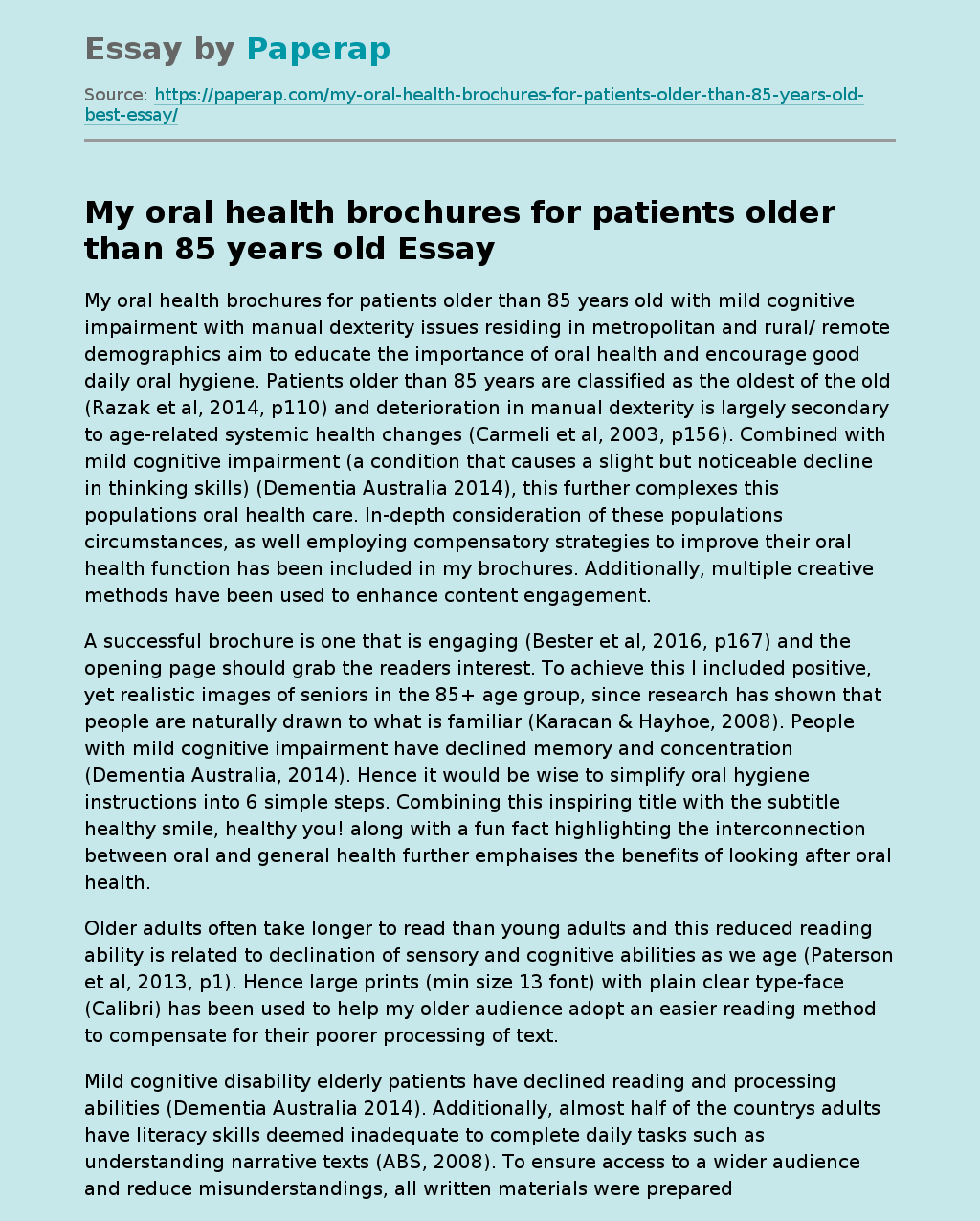Health for Patients Older Than 85 Years Old
My oral health brochures for patients older than 85 years old with mild cognitive impairment with manual dexterity issues residing in metropolitan and rural/ remote demographics aim to educate the importance of oral health and encourage good daily oral hygiene. Patients older than 85 years are classified as the oldest of the old (Razak et al, 2014, p110) and deterioration in manual dexterity is largely secondary to age-related systemic health changes (Carmeli et al, 2003, p156).
Combined with mild cognitive impairment (a condition that causes a slight but noticeable decline in thinking skills) (Dementia Australia 2014), this further complexes this populations oral health care.
In-depth consideration of these populations circumstances, as well employing compensatory strategies to improve their oral health function has been included in my brochures. Additionally, multiple creative methods have been used to enhance content engagement.
A successful brochure is one that is engaging (Bester et al, 2016, p167) and the opening page should grab the readers interest. To achieve this I included positive, yet realistic images of seniors in the 85+ age group, since research has shown that people are naturally drawn to what is familiar (Karacan & Hayhoe, 2008).
People with mild cognitive impairment have declined memory and concentration (Dementia Australia, 2014). Hence it would be wise to simplify oral hygiene instructions into 6 simple steps. Combining this inspiring title with the subtitle healthy smile, healthy you! along with a fun fact highlighting the interconnection between oral and general health further emphaises the benefits of looking after oral health.
Older adults often take longer to read than young adults and this reduced reading ability is related to declination of sensory and cognitive abilities as we age (Paterson et al, 2013, p1).
Hence large prints (min size 13 font) with plain clear type-face (Calibri) has been used to help my older audience adopt an easier reading method to compensate for their poorer processing of text.
Mild cognitive disability elderly patients have declined reading and processing abilities (Dementia Australia 2014). Additionally, almost half of the countrys adults have literacy skills deemed inadequate to complete daily tasks such as understanding narrative texts (ABS, 2008). To ensure access to a wider audience and reduce misunderstandings, all written materials were prepared in plain English using one or two worder syllables and simple terms. Furthermore, paragraphs are mainly short, in dot points or short sentences to make information easier to process and increase engagement. To help readers rehearse information easier, active instead to passive voicing was used to make instructions clear and simple.
Colour distinguishing becomes more challenging for the elderly compared to younger people (Owsley, 2011) as they require three times the amount of light to see (Atkinson, 2004). Colourful information boxes were used to boost interest. This was contrasted against my blue background, which is the colour found to increase readers mental alertness and trustworthiness of information (Andrew Elliot, 2015, p. 4). Colour coding each oral health step helped organise the information, and reduce the demand on the readers memory and confusion- another compensatory strategy to enhance the readers concentration skills and engagement.
Patients with reduced manual dexterity may have a weakened grip (Razak et al, 2014, p. 114) and may experience difficult in grasping items. Multiple adaptive aids such as larger handled toothbrush and elongated handles have been included in the instructions to improve oral hygiene techniques. Visuals and examples have been included to help readers better understand and remember key information.
Oral health in non-metropolitan areas is poorer than metropolitan areas from a combination of fewer dental services, non-fluoridated water supplies and lower socioeconomic factors (NRHA, 2013). In addition, greater distances make dental treatment and purchasing consumer goods more difficult (AIHW, 2013). To account for these disadvantages, oral hygiene tools such as Waterpiks and three-headed toothbrushes have been omitted in my rural brochure. Additional aids like Neutrofluor 5000 toothpaste and Biotene mouthrinse have also been excluded in the rural brochure and replaced with homecare prevention methods such as more frequent consumption of water, good oral hygiene routines and reducing caffeine consumption.
The majority of my audience are likely partially dentate, since patients over 75 years old have on average 24.3 decayed, missing or filled teeth (NSAOH, 2006). Walsh 2017, p.154 stresses that the wearing of partial dentures can lead to up to a six-fold increase in the frequency of root surface caries on adjacent teeth. Hence it would be imperative to include a section on denture hygiene in addition to my brushing, interdental cleaning and additional aids sections. Risk education on sugar consumption was also included to ensure a holistic approach to maintaining oral health. (ADA, 2019)
For non-metropolitan patients, waiting lists for public dental care may be long and access to dental care is disadvantaged due to lesser full time equivalent dentists working per 100,000 people as there are in the cities (NRHA, 2013). To help expand patients options, I decided to include a list of possible alternatives to dental services in their brochure. I have also mentioned that dental schools and Aboriginal Clinics may have free or subsidized treatments with shorter waiting lists than public hospitals to instill incentive to reach out for these alternatives.
My brochures conclude with the need for regular dental check-ups to reinforce that although my brochures do provide general advice for the target groups, personalized care is crucial to maximize oral health care.
Health for Patients Older Than 85 Years Old. (2019, Dec 10). Retrieved from https://paperap.com/my-oral-health-brochures-for-patients-older-than-85-years-old-best-essay/

